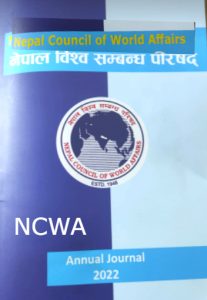Hemanta Kharel
President
Nepal Council of World Affairs (NCWA)
Abstract:
Nepal’s unique geo-Strategic location can be considered as its soft power asset. Existing international relations of Nepal call for skillful diplomacy to take maximum economic and technological benefits from major powerful countries of the world and emerging regional powers. Nepal needs to adopt ‘balanced foreign policy strategy to benefit from economic growth and development of immediate neighbors, super power of the world and other rising powers in the Asia region. Nepal also needs to actively participate in the United Nations and its specialized agencies. Continued cooperative partnership among friendly nations based on our national interest needs to be enhanced to minimize risk and enjoy opportunities of geo-strategic location.
Concept of Geo-Strategic Location:
The term geo-strategy was first used by Fredrick W. Schuman in his 1942 article “Let us Learn Our Geo politics”. Later, it was widely used as challenge and opportunity of geo-strategic location. Now a day’s, Geo-politics and geostrategic words are commonly used to describe geo-strategic location of the country. Geo-politics is ostensibly natural examining the geographic and political features of different regions, especially the impact of geography on politics. Where geo-strategy after involves comprehensive planning, assigning means for achieving national goals or security assets of military or political significance. Some of conceptual views of geo strategic location are given below:
Strategic geography is concerned with control of or access to, spatial areas that affects security and prosperity of nations. Spatial areas that concern strategic geography change with human needs and development. It is also related to geostrategy. (Kemp, 1997) …
If you know a country’s geography, you can understand and predict its foreign policy (Bonaparte).
Geo strategy describes where a state concentrates its efforts by projecting military power and directing diplomatic activity. The underlying assumption is that states have limited resources and are unable, even if that are willing, to conduct a tous auzimuts limits foreign policy. Instead they must focus politically and militarily on specific areas of the world, geo-strategy describes this foreign policy thrust of a state and does not deal with motivation or decision-making process. The geo strategy of a state, therefore, is not necessarily motivated by geographic or geopolitical factors. A state may project power to a location because of ideological reasons, interest groups or simply to whim of its leader (Grygiel, 2006).
Geo strategy is about the exercise of power over particularly critical spaces on the earth surface; about crafting a political presence over the international system. It is aimed at enhancing one’s security and prosperity, about making international system more prosperous; about shaping rather than being shaped. A geo strategy is about securing access to certain trade routes, strategic bottlenecks, rivers, islands and seas. It requires an extensive military presence, normally coterminous with opening of overseas military stations and building of warship capable of deep oceanic power projection. It also requires a network of alliances with other great powers who share one’s aim or with smaller “lynchpin states” that are located in the regions one deems important. (Rogers, 2010).
From above different views it is understandable, how the geo strategic position of a country plays a very important role in determining the domestic and foreign affairs of that country. It has great impact on the economy of a country. It determines whether the foreign investment is desirable or not. It also plays an important role in promoting trade and business.
Nepal’s geo-strategic location has made it possible to establish the headquarters of regional and international agencies such as International Centre for Integrated Mountain Development (ICIMOD), United Nations Regional Centre for Peace and Disarmament in Asia and Pacific (UNRCPD), South Asian Association for Regional Co-operation (SAARC), and UNICEF Regional office for south Asia (ROSA-UNICEF).
Cohen (2010) viewed that the geopolitical structure, its role and capabilities as the geopolitical forces it shapes the international relations system and diplomacy of a nation. If Nepal carefully moves its diplomacy, its geographical location has the ability to influence world politics.
Nepal’s Geo-Strategic Location and its Importance:
Nepal’s central location on the Southern side of imposing mountain system that separates the Tibetan plateau from the plains of India has always strongly conditioned the country’s history and foreign policy (Rose, 2005, p.3).
Nepal is bordered to the South East and West by India and its share of 1700 km border and China to the North having 1400 Km border.
The politico-economic and cultural relationship of Nepal has been closely connected with these two countries since centuries.
Bilateral relations with India and China, despite some fluctuations, have flourished well, but Nepal is unable to share the economic benefit with India and China as per expectations.
Nepal always wants to see both India and China serve Nepal’s interests as a land of opportunity rather than a platform for rivalry.
Geographical location is one of the very important factors conducive to activating geo-politics.
Countries having critical geographical location like Nepal, Bangladesh, Maldives, Sri Lanka and Bhutan have both opportunities and challenges.
Such strategic location has encouraged the involvement of big powers like USA, China and India. Because of weak institutions, fragile civil society and elite control, big powers have been able to increase their influence.
Countries like Nepal have distinctive vulnerabilities. In some, state institutions are brittle.
In others, civil society provides an inadequate check on the actions and power of state elsewhere elites, including external actors are prone to capture.
Therefore, it depends on how the country’s leadership conducts well-crafted foreign policy supported by adept diplomacy. The ground realities of Nepal indicate that the leaders are not able to calibrate its foreign policy using geographical location as an opportunity.
As Nepal is located between two emerging nations of the world, India and China, it constitutes an integral part of their strategic interest in South Asian region.
Nepal is also immensely important for strategic interests of the United States of America which wants to keep this country on its radar by supporting socio-economic development and other matters of Nepal’s concern.
In this context, it is notable that US has offered a dominant role to India in Indo Pacific Strategy (IPS).
Nepal’s strategic significance has been further enhanced by US led West efforts to include Nepal in IPS, so that it can be used as a lever in targeting and countering Chinese influence, including its Belt and Road Initiative (BRI).
The major concern and interest of India and China in Nepal is that any security problems arising from the latter’s territory would have spillover effects on their security.
China is much more worried about the possibility of escalating anti-China elements in Tibet, whereas India’s anxiety is that any overwhelming foreign interest has the possibility of Nepalese territory being used for anti-India activities including its security and strategic interests.
India perceives increasing Chinese interest and influence in South Asian region (SAR), particularly in Nepal, as part of Chinese larger strategy to encircle India.
India’s interest is to maintain its influence in Nepal while China also wants to increase its influence and space to make its foothold much stronger.

The announcement of investment from India and China in the development of infrastructure, basically North South connectivity would bring both surprise and astonishment to all countries involved.
Under Chinese partnership cooperation through BRI, the proposed Sigatse-Kerung-Kathmandu railway, if constructed, may be a game changer in Nepal’s aspiration for economic prosperity.
In the same way, India’s announcement to construct Raxual-Kathmandu and East-West railway (Kakarvitta, Jhapa-Gaddachauki-Kanchanpur 924.80km) which runs parallel to east-west highway would also contribute a lot for economic development of Nepal.
Nepal’s hydropower potential is estimated to be as high as 83,000 MW, out of which 42000 MW is considered technically feasible.
Such a huge hydroelectricity potential could support the Sino-Indian industrialization and economic growth.
Recent bilateral discussion with Bangladesh and India reveals that they plan to buy 15600 MW by 2034 and additional 9000 MW by 2040 respectively from Nepal.
Sri Lanka has also shown its interest to buy electricity via India. If Nepal’s diplomacy works effectively, there is possibility of integrating the region not only within SAARC and BBIN, but also in BIMSTEC and ASEAN countries with land connectivity.
Nepal can be used as a suitable experiment for global climate change.
There is a common view among a large number of countries that climate change is impacting Nepal disproportionately to its size despite its almost negligible contribution to the greenhouse gases.
Nepal’s mountains are becoming more vulnerable due to increased carbon emission on the one hand and on the other hand, the life of Nepalese people living in mountain areas is becoming much harder and harder.
Nepal can be a very popular tourist destination because of its tremendous potentialities.
Out of ten highest mountains of the world, there are nine in Nepal including Mount Everest.
Exciting trekking routes, abundant flora and fauna, cultural and religious diversity, and snow-related sports and protected national parks and conservation of forest areas are attracting tourists from all over the world for entertainment and enjoyment.
Nepal’s unique geo-strategic location between the two most populous counties, China and India, with the population of 1.42 and 1.35 billion respectively which together comprise 36 percent of world population is a great opportunity for Nepal’s economic development through tourism promotion.
The geopolitical risks for Nepal due to its geo-strategic position are high. In the changing international world order, it is extremely difficult for a small state like Nepal to remain neutral to the gravitational pull of powerful states Therefore, Nepal should be careful and avoid possibilities of being the victim of great power politics.
End text.
# Text courtesy: Nepal Council of World Affairs (NCWA) Annual Journal 2022.
#Thanks the distinguished author Hemanta Kharel, President NCWA.
# NCWA Journal King courtesy: Buddhi Narayan Shrestha , Vice President NCWA.
# Our contact email address is: editor.telegraphnepal@gmail.com
References:
Garfano, J. (2004). Alternate Security Strategies: The Strategic Feasibility of Various nations of Security. International Peace Research Foundation.
Grygiel J.J. (2006). Great Powers and Geopolitical Change Johns Hopkins University
Press: Baltimore.
Gray. C.S. & Span, G. (1999). Geo politics geography and Strategy. London, Portland Oregon: Frank Cass.
Ministry of Foreign Affairs. (2022). http:/moga.gov.np/foreign policy.
Kemp G., Harkavy R. (1997). Strategic Geography and the changing Middle East.
Carnegie Endowment for International Peace in cooperation: Brookings
Institution Press. Washington.
Kumar, R. (2017). Geo-Strategic Status of Nepal between India and China, A Security
perspective. Gandhinagar, Gujrat : Centre for International Studies, Central
University of Gujrat.
Rose, L.E. (1971). Nepal: Strategy for Survival. California: University of California
press.
Rogers, J. and Simón, L. (2010). “Think Again: European Geostrategy”. https://web.
archive.org/web/20100424042233/http://europeangeostrategy.ideasoneurope. eu/2010/03/14/think-again-european-geostrategy/

